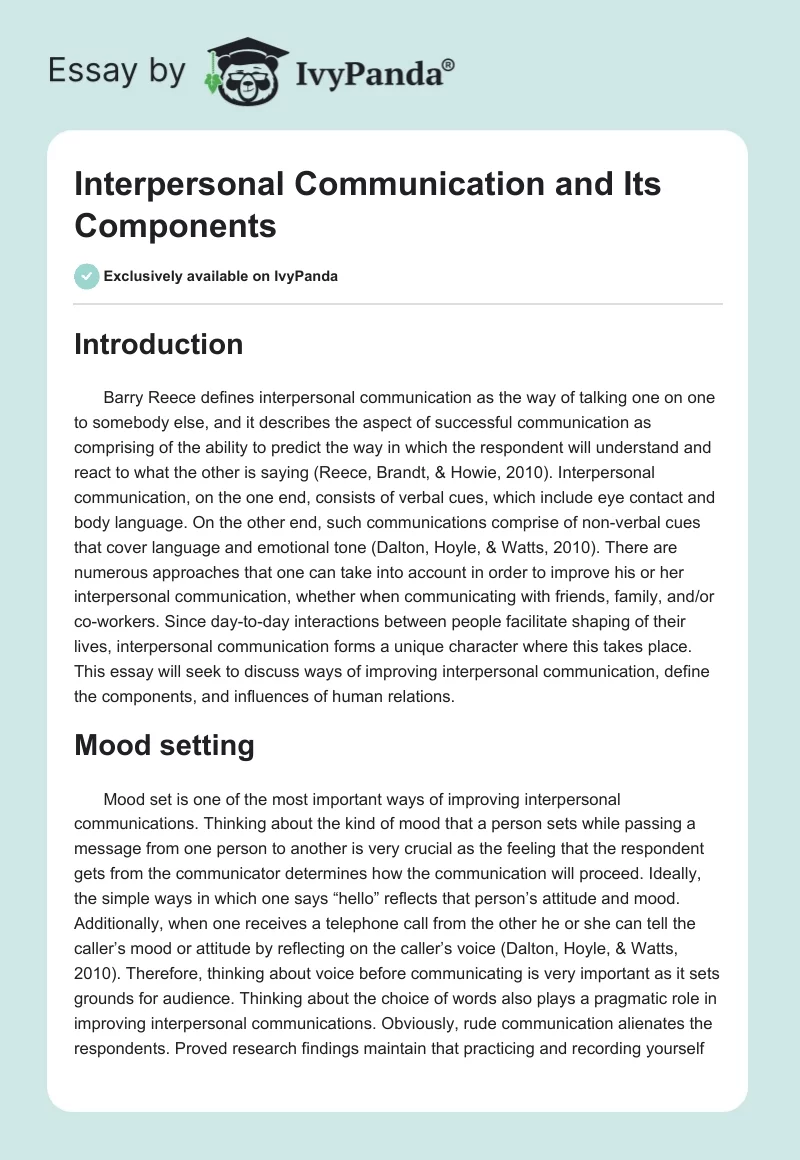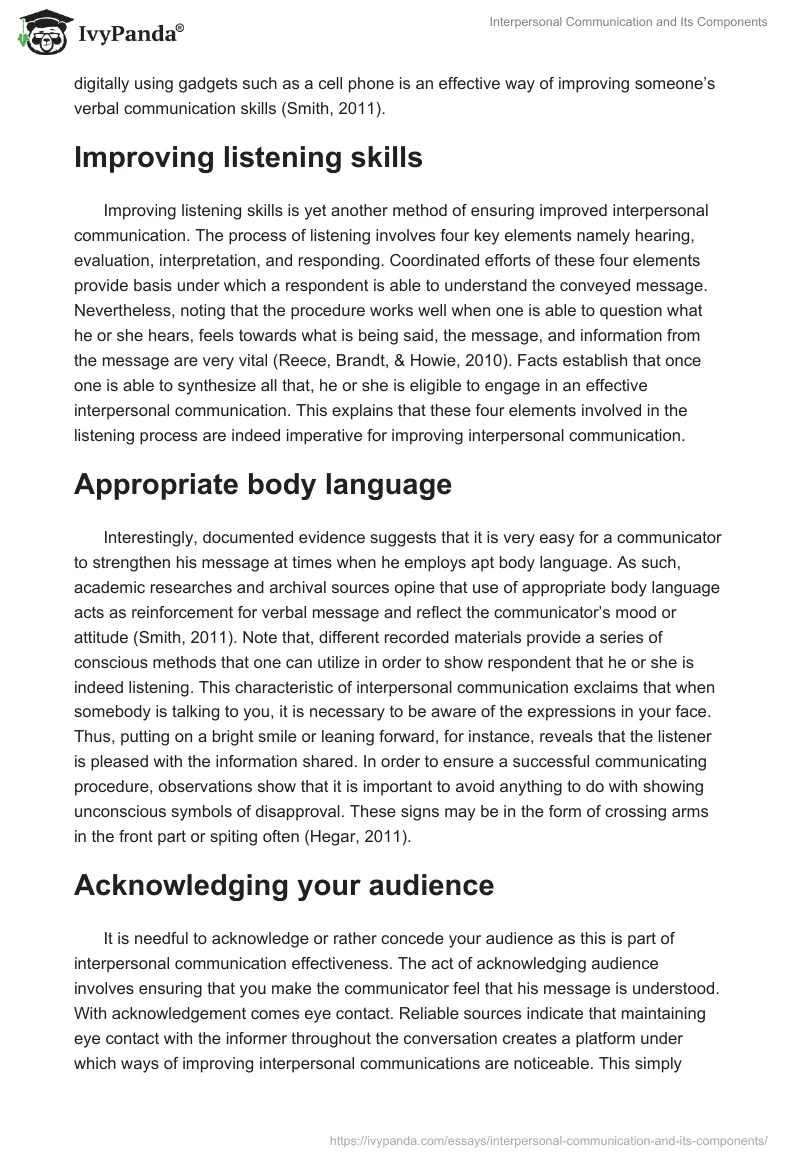Introduction
Barry Reece defines interpersonal communication as the way of talking one on one to somebody else, and it describes the aspect of successful communication as comprising of the ability to predict the way in which the respondent will understand and react to what the other is saying (Reece, Brandt, & Howie, 2010). Interpersonal communication, on the one end, consists of verbal cues, which include eye contact and body language. On the other end, such communications comprise of non-verbal cues that cover language and emotional tone (Dalton, Hoyle, & Watts, 2010). There are numerous approaches that one can take into account in order to improve his or her interpersonal communication, whether when communicating with friends, family, and/or co-workers. Since day-to-day interactions between people facilitate shaping of their lives, interpersonal communication forms a unique character where this takes place. This essay will seek to discuss ways of improving interpersonal communication, define the components, and influences of human relations.
Mood setting
Mood set is one of the most important ways of improving interpersonal communications. Thinking about the kind of mood that a person sets while passing a message from one person to another is very crucial as the feeling that the respondent gets from the communicator determines how the communication will proceed. Ideally, the simple ways in which one says “hello” reflects that person’s attitude and mood. Additionally, when one receives a telephone call from the other he or she can tell the caller’s mood or attitude by reflecting on the caller’s voice (Dalton, Hoyle, & Watts, 2010). Therefore, thinking about voice before communicating is very important as it sets grounds for audience. Thinking about the choice of words also plays a pragmatic role in improving interpersonal communications. Obviously, rude communication alienates the respondents. Proved research findings maintain that practicing and recording yourself digitally using gadgets such as a cell phone is an effective way of improving someone’s verbal communication skills (Smith, 2011).
Improving listening skills
Improving listening skills is yet another method of ensuring improved interpersonal communication. The process of listening involves four key elements namely hearing, evaluation, interpretation, and responding. Coordinated efforts of these four elements provide basis under which a respondent is able to understand the conveyed message. Nevertheless, noting that the procedure works well when one is able to question what he or she hears, feels towards what is being said, the message, and information from the message are very vital (Reece, Brandt, & Howie, 2010). Facts establish that once one is able to synthesize all that, he or she is eligible to engage in an effective interpersonal communication. This explains that these four elements involved in the listening process are indeed imperative for improving interpersonal communication.
Appropriate body language
Interestingly, documented evidence suggests that it is very easy for a communicator to strengthen his message at times when he employs apt body language. As such, academic researches and archival sources opine that use of appropriate body language acts as reinforcement for verbal message and reflect the communicator’s mood or attitude (Smith, 2011). Note that, different recorded materials provide a series of conscious methods that one can utilize in order to show respondent that he or she is indeed listening. This characteristic of interpersonal communication exclaims that when somebody is talking to you, it is necessary to be aware of the expressions in your face. Thus, putting on a bright smile or leaning forward, for instance, reveals that the listener is pleased with the information shared. In order to ensure a successful communicating procedure, observations show that it is important to avoid anything to do with showing unconscious symbols of disapproval. These signs may be in the form of crossing arms in the front part or spiting often (Hegar, 2011).
Acknowledging your audience
It is needful to acknowledge or rather concede your audience as this is part of interpersonal communication effectiveness. The act of acknowledging audience involves ensuring that you make the communicator feel that his message is understood. With acknowledgement comes eye contact. Reliable sources indicate that maintaining eye contact with the informer throughout the conversation creates a platform under which ways of improving interpersonal communications are noticeable. This simply means that eye contact vets whether the method used during that particular interpersonal communication needs improvement or not (Smith, 2011). On the other hand, asking questions after or in between the conversation reveals that you were without a doubt listening. Certainly, this factor helps improve interpersonal communications in any status since asking questions implies the need for clarification, which is a substantial test to seek to know whether the listener was listening (Hegar, 2011).
Components of Human relations
Human relations encompass the overall scope of people’s interaction. An effective human relation upholds the concern, consideration, and working cooperation of every child and adult including ethnic and racial groups. Feelings, inspirations, and experiences shape the quality of human interaction whereas the characteristics that are all common to humans influence ways in which they respond. Motivation is an important component present in human relations (Hegar, 2011). According to human relations training, motivation is very crucial in this field as it provides a framework under which people are able to understand why they act the way that they do. In a working place, motivation gives people the zeal to work. Substantially, internal motivation happens when one performs a task or duty that is in itself an incentive or a reward. Externally, a person is able to initiate motivation on another by involving rewards and other types of reinforcements that boosts the other person’s morale to work even more and better (Dalton, Hoyle, & Watts, 2010).
Culture is another element of human relations. Interestingly, for humans to relate freely they must be able to understand each other correctly. However, there are some factors such as a culture that cannot be disregarded when relations are potent. A sound human relation puts into account and reflects the aspect of cultural factors. Human interaction does not have the capability to change a cultural system, but it can affect people’s behavior within a set cultural environment (Reece, Brandt, & Howie, 2010). Thus, in order to set a sound human relation, the concerned people should only describe part of elements that have general contribution towards establishing an effective human relation system. As such, the collected elements would make a constitution of some sort of “check list”. Relatively, an industrious human relation would consider and exhibit the essence of these elements extracted from the cultural setting.
Moreover, understanding forms a pragmatic part of human relations. Bearing in mind the fact that this is the people’s planet, and that people live through interactions it becomes inevitable to agree that adjusting to suit the necessary requirements for interaction is very vital (Smith, 2011). When people develop the facet of understanding, groups and individuals hailing from diverse backgrounds are able to interact and relate. Usually, in instances where the involved parties fail to establish a feature of understanding one another, they cannot proceed with their activities without understanding each other. Preferably, being thoughtful and perceptive about other people’s point of view constantly adjusts and redefines how they relate. This perception constitutes to a profound approach towards a rationale system of human relations.
Influences of Human relations
In the field of business, technology has a huge influence on human relations. Furthermore, technology eases and enhances coordination of human resources. The use of updated technological devices in the field of human resource creates fresh ways of recording employment actions, tracking compensations, and recruiting applicants as well as assessment of benefits (Dalton, Hoyle, & Watts, 2010). Technology influences human relations in that, technology minimizes the interaction of humans to humans because of the idea that use of technological devices takes the place of humans in undertaking different tasks. As a result, interaction from one person to another reduces drastically as others communicate through other technologically powered mediums such as computers (Hegar, 2011).
Race, ethnicity, and gender also influence interactions between humans. In areas where racial issues are rampant, relations between people of different races are always sore. Definitely, if people face challenges while speaking to others of different cultural or tribal background it becomes stringent and undeniably detrimental to relate freely (Hegar, 2011). This aspect brings about an influential factor that is of the essence when describing elements that affect human relations. Moreover, ethnicity in the context of a minority group of people paints a stereotyped picture of how such people relate to others. For instance, the minority groups of people of African decency in the United States relate differently with the whites and their fellow real Africans. Recent reports show that African Americans related slightly freely with their white counterparts (Smith, 2011). Conversely, they exhibit series of strong disregard for their fellow Africans mainly because of thought that Africans belittle them. Perhaps, it is with this respect that women from different communities relate freely with other women and relatively parsimoniously with men. Hence, it is true to say that these elements influences human relations to the highest degree.
Conclusion
In conclusion, ways in which people can improve their interpersonal relations between and among themselves are wide and broad. What matters a lot is the spirit in which they apply these personal attributes believed to aid their opportunities of improvement in terms of interpersonal communication (Reece, Brandt, & Howie, 2010). Mood setting, use of the appropriate body language, acknowledging audience are just part of the many ways that people can employ with the aim of enhancing their ability to communicate interpersonally. Motivation, culture, and the aspect of conformity or simply understanding represent the numerous factors that compose human relations (Dalton, Hoyle, & Watts, 2010). Further, technology, race, and ethnicity as well as gender shift the focus of how humans interact with one another by influencing their relations. It is therefore recommendable that for one to see change in his or her life, he or she has to concede and/or break from old negative habits and choose to foster the development by accepting and formulating positive habits. However, for this to happen, one must set goals, which he or she should then reinforce them through motivation, knowledge, and practice.
References
Dalton, M., Hoyle, G. & Watts, M. (2010). Human Relations. New York: Cengage Learning.
Hegar, K. (2011). Modern Human Relations at Work. New York: Cengage Learning.
Reece, B. (2011). Human Relations: Principles and Practices. New York: Cengage Learning.
Reece, B., Brandt, R. & Howie, K. (2010). Effective Human Relations: Interpersonal and Organizational Applications. New York: Cengage Learning.
Smith, S. (2011). Application on Human Relations Theory in Primary Schools. Munich: GRIN Verlag.


